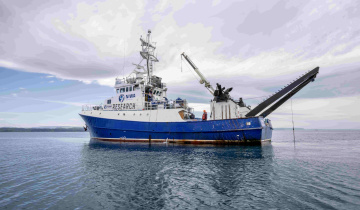French researchers are now, or soon to be, closely involved in a range of New Zealand environmental and marine studies taking in such diverse activities as migratory problems of fish including eels, the foraging habits of royal albatross in southern oceans, and the potential tsunami impact of undersea landslides.
26 February 1999
"French scientific collaboration is helping advance these studies that hold special significance to various New Zealand interests," says the Chief Executive of the National Institute of Water and Atmospheric Research (NIWA), Mr Paul Hargreaves.
"Financing for the projects comes from the Public Good Science Fund and the French Government. It enables the researchers of both countries to access knowledge, equipment, facilities, and unique environments that neither group could access on its own."
The French researchers are working with NIWA staff at their laboratories in Hamilton, Wellington, and Christchurch.
Dr Bryce Cooper, Regional Manager, Hamilton, of NIWA, says one project embraces the testing of new fish passes that will help migratory fish, including eels, get past barriers such as dams for power generation or water supply and road culverts.
"We are trying to make it easier for young eels (elvers) coming in from the sea to get up river to smaller streams while at the same time helping mature eels, some of which may be up to 70 years old, to have a safe passage when migrating to spawn at sea in the Tonga Trench. Iwi and power companies are involved and have a strong interest in the outcome of the tests, which have potential application in Europe as well as throughout New Zealand."
Dr Paul Sagar, a marine scientist based at NIWA’s Christchurch facilities, says four years of collaboration with French funding between NIWA, the French CNRS laboratory at Chize, and Lincoln University has enabled extensive studies of albatross activities.
"As one of the top predators in the marine ecosystem seabirds are a good indicator of change in the abundance of marine resources. The research has considerable conservation implications because many populations of albatrosses and other seabirds in the subantarctic have been, and continue to be, severely affected by fishing operations.
The research has concentrated on the southern royal grey-headed and black-browed albatrosses breeding on Campbell Island and Buller’s albatrosses breeding on The Snares in the New Zealand subantarctic. Comparisons are made with the activities of seabirds inhabiting the French subantarctic islands of Kerguelen and Crozet.
Albatrosses are banded and then tracked by satellite across the Pacific to Chile, on 12-day return flights to Tasmania from The Snares and Campbell Island and two-day flights covering some 300 to 400 kilometres.
Monitoring has shown that about 60 percent of albatross diet is now offal from trawl fishing activities. Buller’s albatrosses are proving to be the most susceptible to catch on longline fishing hooks.
Ongoing French scientific involvement in New Zealand also includes research work related to enormous avalanches that occur on the continental shelf, principally between Mahia and East Cape.
Wellington-based NIWA marine geologist Keith Lewis, who will work with French geophysicist Jean-Yves Collot, says new information disclosed that big seamounts are being carried on the Pacific plate into and under the continental slope, destabilising it. He says the impact is severe because of the angle at which seamounts impact the New Zealand margin.
"One avalanche we are working on probably occurred some 100,000 years ago and was the equivalent to a mass of rock as big as the Coromandel Peninsula suddenly falling down a three kilometre slope. A similar sized submarine avalanche off Hawaii threw coral boulders more than 200 metres above sea level and removed the red soil from as high as 370 metres above sea level.
"We are talking here about events that may occur once in every 100,000 to 200,000 years. But further south off Kaikoura, where sand, gravel and mud pour constantly over the shelf edge into the steep Kaikoura Canyon, there is a major landslide every 100 to 200 years triggered by earthquakes at nearby faults.
"Could tsunamis occur as a result of these submarine avalanches? The answer is yes. But we don’t know how big they would be on any coast. French colleagues have the expertise required to work with us on modelling potential tsunami impacts based on submarine landslide volumes.
"The information is essential for civil defence planning and for engineering of offshore and coastal installations. It is therefore vital for us to establish procedures that will allow us to assess the likely impact of future submarine landslides that we may anticipate from seabed monitoring."






